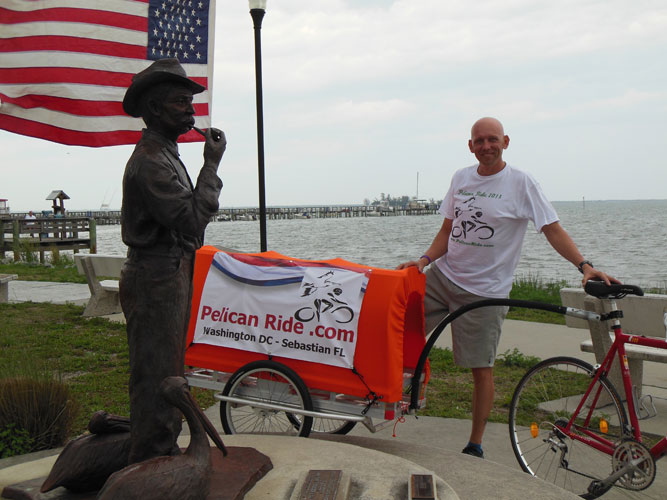
SEBASTIAN — He’s set world kayaking records. He’s been known to run the equivalent of several marathons rolled into one. And now Mike Beck is riding a bicycle with a large American flag on the back to raise awareness and money for one of the area’s important and historic gems – Pelican Island National Wildlife Refuge.
Thursday marked Day Seven of Beck’s journey from Washington, D.C., to Sebastian.
“I hope to get into a groove,” said Beck of the cool weather and long hours on a bicycle ahead of him while heading to Washington.
Beck is expected to arrive at the Pelican Island Wildlife Refuge on March 15.
The following day will not be a day of rest. Instead, he will get out of bed early and head out to meet up with fellow bicyclist and Pelican Island enthusiasts for the 10-mile ride along the Wabasso Causeway and up U.S. 1 to Riverview Park for the 10 a.m. start of the Pelican Island Wildlife Festival on March 16.
“I want as many bicyclists as possible to join us on this ride,” said Kroegel. “I would love to have hundreds of bicyclist. This is not a race. It is a fun ride for anyone of any age.”
The 46-year-old Beck who along with his wife operates the Florida Outdoor Center, a non-profit business that strives to get people outdoors and to appreciate all of the beauty of the area through bicycling, kayaking and walking tours, is hoping the ride generates awareness to the Pelican Island National Wildlife Refuge.
Along his journey, he’ll be making presentations and possibly doing media interviews to draw attention to the area.
The refuge begins just north of the Wabasso Causeway and extends to just south of the Sebastian Inlet.
“We have the beautiful area here,” Beck said.
Beautiful, and historically important. One-hundred-and-ten years ago, the Pelican Island, a then five-acre island in the Indian River Lagoon, became the first land ever designated as a federal bird reservation.
Beck chose to do the ride, which equates to an average of about 100 miles a day, over a 14-day period, because 14 days was how long took President Theodore Roosevelt to designate Pelican Island a refuge.
By today’s standards of often-gridlocked Capitol Hill, the swiftness of getting all of the paperwork signed matter of just two weeks was a feat in itself.
Today, Pelican Island is home to about 30 different types of birds in the midst of nesting season.
For 110 years, these birds and others before them have been protected.
Prior to Roosevelt act in March 1903, a German man by the name of Paul Kroegel took it upon himself to stand guard at the island in an effort to keep plume hunters from decimating the heron, egret, spoonbill and pelican population at a time.
Such bird feathers were worth more than gold to poachers who sold them to the fashion industry.
Beck, who grew up in Germany and like Kroegel now lives in the Sebastian area, chuckles at the similarities he shares with Kroegel who is known as a the refuge’s first ranger.
“There are definitely some parallels,” said Beck. “Many have pointed that out.”
Kroegel built boats and so does Beck. Kroegel also had an unwavering affinity for the area’s wildlife as does Beck today.
For Kroegel, Pelican Island was worth saving. For Beck, Pelican Island is worth not only saving, but promoting.
Beck’s hoping his journey from the nation’s capital will kick off a capital campaign to raise money for a Pelican Island visitor’s center in Sebastian.
At the centennial celebration of the wildlife refuge 10 years ago, there was some buzz generated that perhaps one day there could be a visitor’s center.
Beck and others associated with the refuge are hoping that Beck’s ride jumpstarts the effort once again.
Tim Glover, a board member of the Pelican Island Preservation Society hopes to help make the decade-old vision of a visitor center come to fruition.
“Kevin Lowry came to work at the refuge a little over a year ago as their outreach person and is working on their renewed interest in the center,” Glover said. “There is lots of interest in having such a facility, but there are no specific plans at this time. One of the reasons is that the refuge doesn’t believe it is realistic to be able to get the funding from the federal government for such a project, in the foreseeable future.”
That means a grassroots effort to raise private dollars. Beck’s ride from Washington, D.C. is designed to ignite enough interest to launch that kind of capital campaign.
“The refuge has built new offices at the refuge to accommodate their staff on site, instead of in downtown Vero. They also have a small office in the building just to be able to greet the public and answer questions,” Glover said. “But their desire is to have a formal visitor’s center on the mainland in Sebastian, and naturally the Chamber and the city are excited about this.”
Glover said the refuge is hoping that the Pelican Island Preservation Society would be able to undertake a major fund-raising campaign to raise the money to build such a facility.
“It is certainly a big undertaking for PIPS and we are still working to figure out how to get started,” Glover said, adding that a meet and greet event is tentatively planned for April.
To learn more about Mike Beck’s journey from Washington, D.C., to Sebastian, go to www.pelicanride.com.
To learn more about Pelican Island and its history, go to www.pelicanisland.fws.gov.



